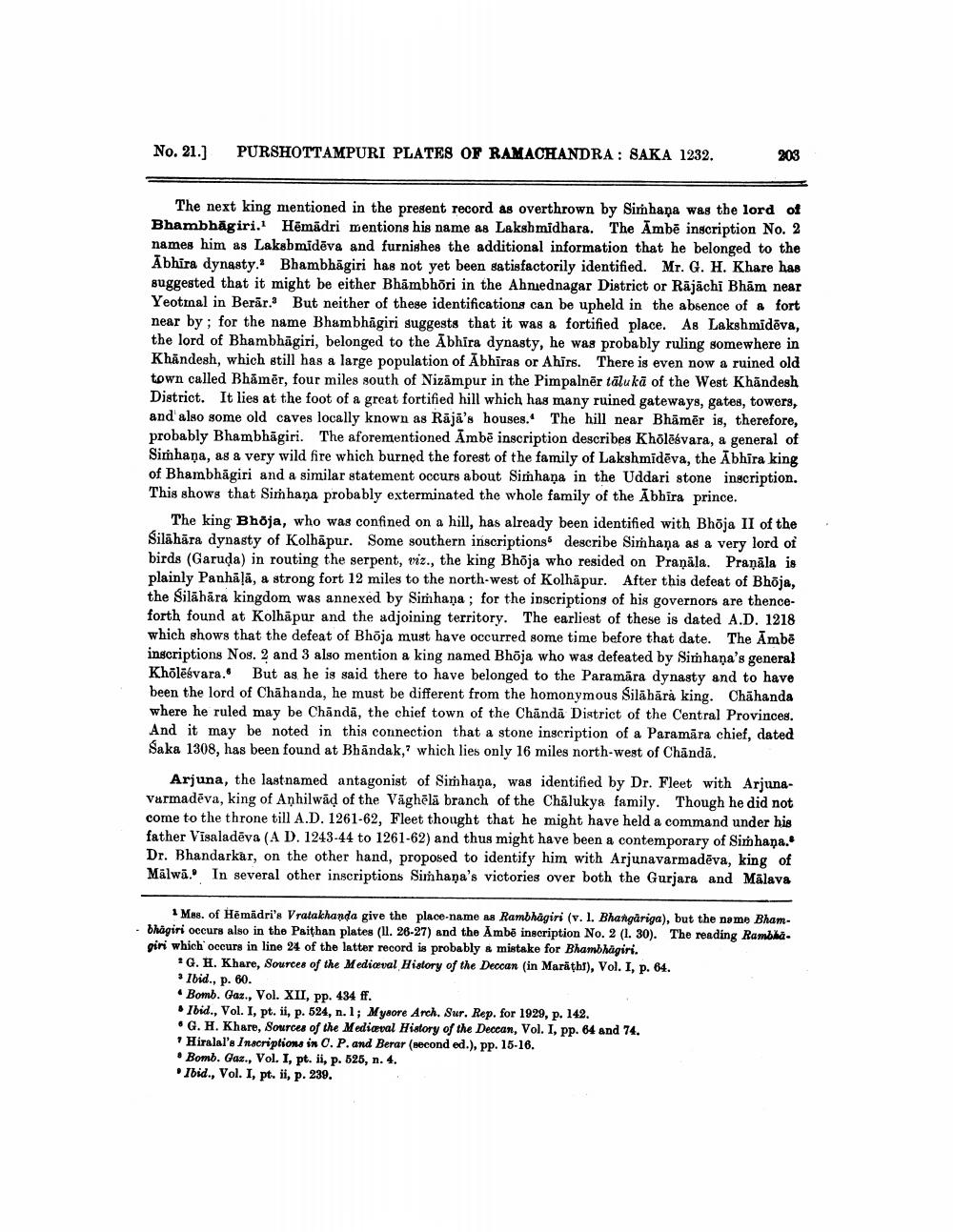________________
No. 21.)
PURSHOTTAMPURI PLATES OF RAMACHANDRA: SAKA 1232.
203
The next king mentioned in the present record as overthrown by Simhana was the lord of Bhambhāgiri. Hēmādri mentions his name as Lakshmidhara. The Ambē inscription No. 2 names him as Laksbmidēva and furnishes the additional information that he belonged to the Abhira dynasty.' Bhambhāgiri has not yet been satisfactorily identified. Mr. G. H. Khare has suggested that it might be either Bhambhori in the Ahnednagar District or Räjächi Bhām near Yeotmal in Berār. But neither of these identifications can be upheld in the absence of a fort near by; for the name Bhambhagiri suggests that it was a fortified place. As Lakshmidēva, the lord of Bhambhāgiri, belonged to the Abhira dynasty, he was probably ruling somewhere in Khandesh, which still has a large population of Abhiras or Ahirs. There is even now a ruined old town called Bhāmēr, four miles south of Nizāmpur in the Pimpalnēr tālu kā of the West Khandesh District. It lies at the foot of a great fortified hill which has many ruined gateways, gates, towers, and also some old caves locally known as Rāja's houses. The hill near Bhāmēr is, therefore, probably Bhambhagiri. The aforementioned Āmbē inscription describes Khölcsvara, a general of Simhana, as a very wild fire which burned the forest of the family of Lakshmidēva, the Abhira king of Bhambhāgiri and a similar statement occurs about Simhana in the Uddari stone inscription. This shows that Simhana probably exterminated the whole family of the Abhira prince.
The king Bhoja, who was confined on a hill, has already been identified with Bhöja II of the Silāhāra dynasty of Kolhapur. Some southern inscriptions describe Simhana as a very lord of birds (Garuda) in routing the serpent, viz., the king Bhoja who resided on Praņāla. Praņāla is plainly Panhāļā, a strong fort 12 miles to the north-west of Kolhapur. After this defeat of Bhoja, the Silāhāra kingdom was annexed by Simhana ; for the inscriptions of his governors are thenceforth found at Kolhapur and the adjoining territory. The earliest of these is dated A.D. 1218 which shows that the defeat of Bhöja must have occurred some time before that date. The Ambe inscriptions Nos. 2 and 3 also mention a king named Bhõja who was defeated by Simhaņa's general Khõlēsvara. But as he is said there to have belonged to the Paramāra dynasty and to have been the lord of Chāhanda, he must be different from the homonymous Silābārå king. Chāhanda where he ruled may be Chandā, the chief town of the Chandā District of the Central Provinces. And it may be noted in this connection that a stone inscription of a Paramāra chief, dated Saka 1308, has been found at Bhāndak," which lies only 16 miles north-west of Chandā.
Arjuna, the lastnamed antagonist of Simhaņa, was identified by Dr. Fleet with ArjunaVurmadēva, king of Anhilwad of the Väghēlā branch of the Chālukya family. Though he did not come to the throne till A.D. 1261-62, Fleet thought that he might have held a command under his father Visaladēva (A D. 1243-44 to 1261-62) and thus might have been a contemporary of Simhana. Dr. Bhandarkar, on the other hand, proposed to identify him with Arjunavarmadēva, king of Mälwa. In several other inscriptions Simhana's victories over both the Gurjara and Mälava
1 M88. of Hēmädri's Vratakhanda give the place name as Rambhagiri (v. 1. Bhangåriga), but the name Bham· bhagiri occurs also in the Paithan plates (11. 26-27) and the Ambē inscription No. 2 (1. 30). The reading Rambla. piri which occurs in line 24 of the latter record is probably & mistake for Bhambhagiri.
*G. H. Khare, Sources of the Mediaeval History of the Deccan (in Marathi), Vol. I, p. 64. • Ibid., p. 60. • Bomb. Gaz., Vol. XII, pp. 434 ff.
Ibid., Vol. I, pt. ii, p. 524, n. 1; Mysore Arch. Sur. Rep. for 1929, p. 142. .G. H. Khare, Sources of the Medieval History of the Deccan, Vol. I, pp. 64 and 74.
Hiralal's Inscriptions in O. P. and Berar (second ed.), pp. 15-16. • Bomb. Gaz., Vol. I, pt. ii, p. 525, n. 4. Ibid., Vol. I, pt. ii, p. 239.




